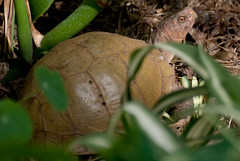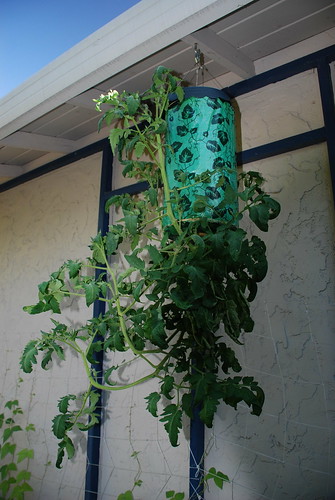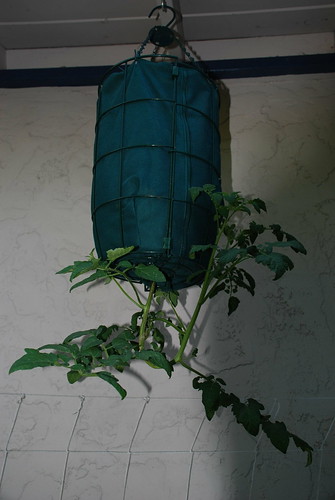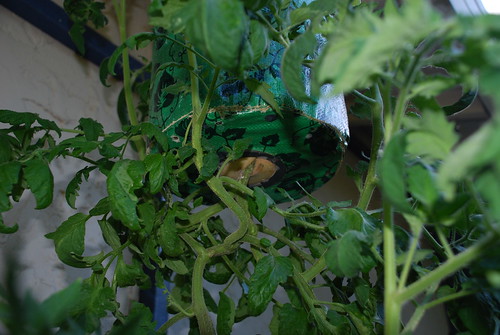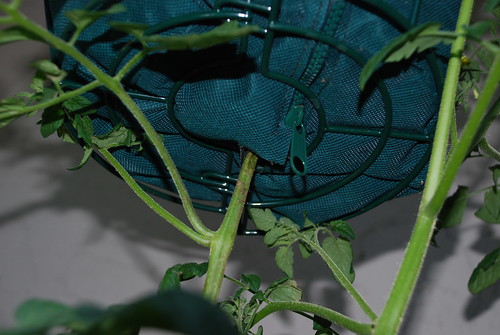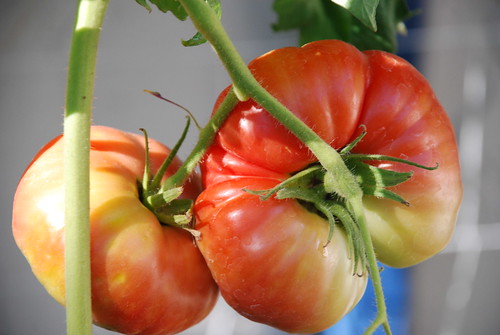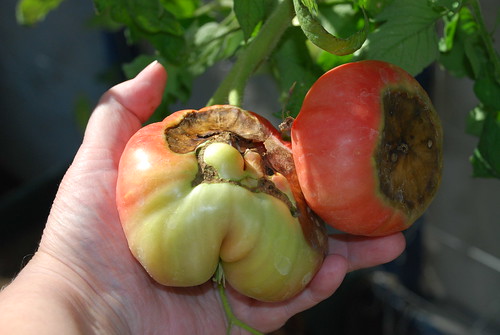Actually, Mom and I together bought two each of two different manufacturer's styles. The ones we purchased at Orchard Supply Hardware were made of a woven plastic fabric attached to a wire frame at the top that hung from wires.
The planters we bought online from Gardener's Supply (gardeners.com) had a heavy wire cage structure with a heavy fabric lining that zips open and closed with a heavy zipper. The heavy wire cage hangs from chains.
Both types have an opening at the base where you plant your tomato so that, when the planter is hung, the tomato plant will grow downward... then try to reach up.
The two different planter types present their own particular advantages and issues in terms of assembly, but we haven't developed a preference of one over the other.
One really big difference between the two planters is that the one from Gardener's comes with a reservoir and a few capillary strips. When you've assembled your fully-planted planter, you lay one of the strips on top of the soil, set the reservoir in on top of the strip, then fold the other end of the strip into the reservoir. The idea is that the combination of reservoir and capillary strip will provide constant moisture to the rootball. But the thing is that it provides such a constant level of moisture that it drips out the bottom continuously, albeit slowly. Side note: you can't put fertilizer in the reservoir or the capillary strip will develop algae and it will quit working.
Both planters instruct you to water daily. This turns out not to be strictly necessary, but you really need to keep an eye on the heat and wind if you don't plan to water daily. Otherwise you get up the next morning and find your plant hanging all limp.
Our Results
As I mentioned above, if you're not very careful about your watering schedule, you're going to end up with a limp plant. The problem I encountered there is that I had a few green Brandywine tomatoes coming on that were a little larger than golfballs. The next thing I know, they've got blossom end rot. The book says that this is caused by low calcium (not bloody likely given the amount of calcium in our soil and city water) or by "uneven watering." I think going dry counts as "uneven." So, while I had tomatoes that looked like this:
The other side looked like this:
Happily, after this catastrophe, I watered daily and have plenty of new green Brandywine tomatoes coming on and the Super Sweet 100 (cherry-type) tomatoes never suffered from drought (reservoir and capillary strips) and, therefore, didn't suffer from blossom end rot.
On the other hand, both plants seem a little anemic -- especially the Super Sweet 100 in the OSH planter with the constantly-dripping reservoir. And the fruits of the SS100 are uneven in that some of them act like they are trying to dehydrate on the vine even tho they're not yet ripe and there's plenty of water dripping from the base.
The Issues
For those who haven't raised tomatoes, here are a few rules of thumb about growing them in the ground:
- Water them minimally once they are established. This forces them to put down deep roots where they can find mineral nutrients they need for blossoming and fruiting.
- Fertilize them minimally or at least NOT with nitrogen. Nitrogen encourages lots of leaf growth and not roots, blossoms, and fruit.
- Keep them up, off the ground, or soil microbes will take over and rot your fruit quickly.
So, these hanging planters need you to water daily, offer no root room, and need to be carefully fertilized for optimum growth. The one bonus is that, because they are hanging, you don't have to worry about staking or tomato cages. It's also a lot easier to harvest what's there right at shoulder height.
Final Recommendation
Overall, I suppose they're nice for the novelty or if you really don't have any other place to grow tomatoes, but they're awfully fussy and the results aren't all that spectacular. For example, Mom has also planted tomatoes in 5-gallon and 15-gallon pots this year and those are doing better than her hanging tomatoes.
